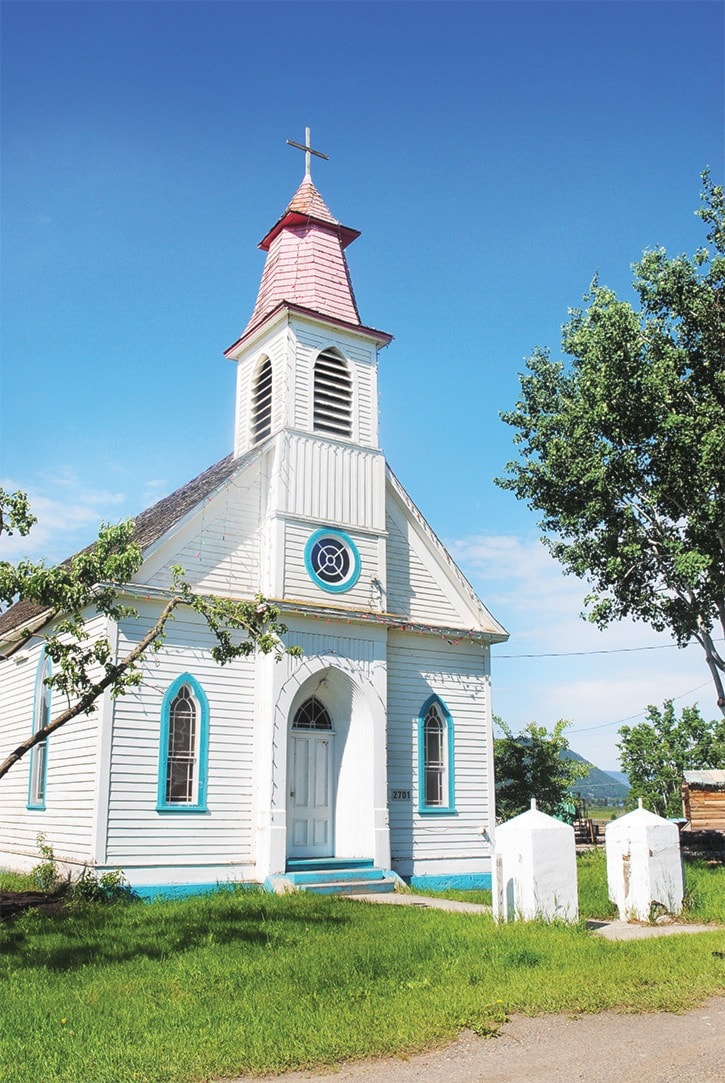A 118 year old member of the community is getting a face lift.
Last week the Williams Lake Indian Band learned its application to the Heritage Legacy Fund to carry out restoration of the Sugar Cane Church was successful.
“We learned we have been approved for $22,997,” WLIB councillor Rick Gilbert said.
There was only $180,000 in the pot, and WLIB was one of three applications to be granted the full amount of its request.
The church, formally known as the The Church of the Immaculate Conception, will receive a new roof, new paint, a new gate and fence, and perhaps a new cross atop its red steeple.
Gilbert will know about what’s needed once he and his crew climb up some scaffolding to examine things more closely.
“Heritage funding can only be used for work on the outside of the church,” he said.
Gilbert is a former chief.
Last year he and his wife, who is an American, returned to live at Sugar Cane.
“I was gone about 14 years,” he said. “My wife is from Mississippi and we lived there for about four years.”
He was almost immediately elected on council and one of the things he did was see if the band could acquire some funding for restoring the church.
“The last time we had a major renovation was in 1982,” he recalled. “I was the chief back then. We re-roofed, painted all of the outside and firmed up anything that needed firming up.”
They also repainted the inside, but laughing he explained the priest serving the church at the time had suggested a blue ceiling and beige walls.
The opposite painting was completed and when the priest returned to visit, he was shocked.
“He had a fit, but he got over it,” Gilbert chuckled.
Already some volunteers have been working in anticipation of the upcoming work.
They’ve torn down an old fence, cleared some of the grounds around the church, pruned trees, cleaned up the inside, and are planning to install some electric heaters that will augment the only source of heat — one wood burning stove inside.
“Have you ever been in here in the winter?” Gilbert asked. “It can be pretty cold.”
Kids are often clad in snowsuits, boots, hats and gloves to attend mass in the winter, and during one mass the priest was trying to thaw the water inside a bottle that he needed to use at the altar by placing it close to his body.
“We’ve only used wood for 118 years now,” he said. “Electric will heat up the place faster though.”
There are also plans to update all the wiring and replace the flooring, paint the inside, and the big hope is that an additional small building could be erected outside with washrooms.
“They’ve gone without washrooms forever, but maybe it’s time to provide some amenities,” he said. “We are hoping some generous benefactor will come forward to solve this problem for us.”
A few of the original pews remain, but the majority are quite long so there are also plans to modify them to make an aisle more in the centre.
To receive heritage funding, the band is required to provide at least the equivalent amount in cash or in-kind services.
Already volunteers have been working to prepare for the major work that will be done.
Gilbert said the church was built at the site 14 years after his people moved to live on the newly created Sugar Cane Reserve in 1881.
“The missionaries at St. Joseph Mission had invited our people to live at the mission and they kept pressuring the government to give us some land,” he said.
Eventually the government purchased three ranches, one of them was called the Sugar Cane Ranch, and added some Crown land to create a 4,000-acre parcel of land for the band.
“The church was built by the missionaries and our people,” Gilbert said. “There’s actually some real craftsmanship inside that’s still amazing after 118 years.”
He was born at Sugar Cane and lived in an old log house near the church that stands empty today.
There are the remains of three buildings, where once there were about 50.
“They used to have prayers here in the morning and the evening every day, and mass was on Sunday,” he said. “Now mass is only once a month, and mostly outsiders come to church here.”
He said a lot of his people turned away because of the residential school experience, but a few of the elders are “hanging in there” and trying to bring it back to the young people.
“We’re hoping to start having some catechism and religious teaching again.”
The church is too small for weddings or funerals, so those services are usually held at the community gym, he added.
Gilbert hopes that everyone in the region will see the church as one of its heritage sites.
“Last time we painted it you could see the bright red steeple when you drove around the point from Williams Lake.
“The church has been in different magazines and newspapers over the years so people got to know it.”
Gilbert has developed a website for the church that includes historical photographs.
